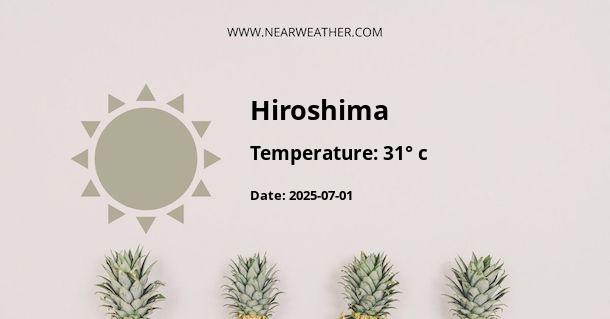Hiroshima-shi, Japan: Climate and Weather Year Round
Hiroshima-shi, or simply Hiroshima, is a city located in the southwestern part of Japan's main island, Honshu. Famous for its historical significance as the site of the atomic bombing during World War II, Hiroshima is now a vibrant and thriving city with a rich cultural heritage. In this article, we will explore the climate and weather patterns in Hiroshima throughout the year.
Climate Classification
Hiroshima experiences a humid subtropical climate, categorized as Cfa according to the Köppen climate classification system. This means that the city has hot and humid summers, mild winters, and a significant amount of rainfall throughout the year.
Seasonal Temperatures
The temperatures in Hiroshima vary significantly between the different seasons. Let's take a closer look at the average temperatures for each season:
| Season | Average Temperature (°C) |
|---|---|
| Spring (March to May) | 10°C to 20°C |
| Summer (June to August) | 25°C to 30°C |
| Autumn (September to November) | 15°C to 25°C |
| Winter (December to February) | 5°C to 10°C |
As seen from the table, summers in Hiroshima can be quite hot, with temperatures reaching as high as 30°C. On the other hand, winters are relatively mild, with temperatures ranging from 5°C to 10°C. Spring and autumn offer pleasant weather with comfortable temperatures between 10°C and 25°C.
Precipitation
Hiroshima receives a significant amount of rainfall throughout the year. The city experiences a rainy season from June to July, with an average precipitation of around 200-300mm per month during this period. The highest rainfall occurs in June, which is often accompanied by occasional thunderstorms.
Furthermore, Hiroshima is also prone to typhoons, especially during the summer and early autumn months. Typhoons can bring heavy rain and strong winds to the region. The peak typhoon season in Hiroshima is usually from August to September.
Sunshine Hours
Hiroshima enjoys a decent amount of sunshine throughout the year. On average, the city receives around 1,800 to 2,000 hours of sunshine annually. The sunniest months are typically from May to July, with June being the sunniest month of the year.
Humidity
Due to its humid subtropical climate, Hiroshima experiences high levels of humidity. The average relative humidity throughout the year is around 70-80%. Summers tend to be more humid, with humidity levels often exceeding 80%. The least humid months are usually during winter.
Best Time to Visit Hiroshima
The best time to visit Hiroshima is during spring (March to May) and autumn (September to November) when the weather is mild and comfortable. These seasons offer pleasant temperatures, lower chances of rainfall, and beautiful cherry blossoms in spring and vibrant foliage in autumn.
However, it is worth noting that Hiroshima is a popular tourist destination, especially during the cherry blossom season, so expect larger crowds during this time. If you prefer a quieter experience, consider visiting during the shoulder seasons of early spring or late autumn.
Conclusion
Hiroshima experiences a humid subtropical climate with hot and humid summers, mild winters, and a significant amount of rainfall throughout the year. The city's temperatures range from 5°C to 30°C, with the most pleasant weather occurring in spring and autumn. The rainy season in Hiroshima is from June to July, and the region is also prone to typhoons during the summer and early autumn months. Visitors can expect a decent amount of sunshine throughout the year, with the sunniest months being from May to July. Overall, Hiroshima offers a diverse climate that can cater to various preferences, making it an attractive destination for tourists.
A - Hiroshima's Latitude is 34.396271 & Longitude is 132.459366.
A - Weather in Hiroshima is 6° today.
A - Climate Conditions in Hiroshima shows light rain today.
A - Humidity in Hiroshima is 81% today.
A - Wind speed in Hiroshima is 14.51 km/h, flowing at 351° wind direction. today.
